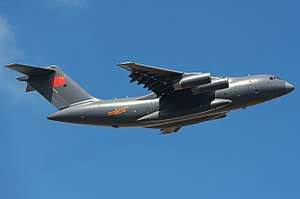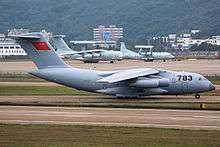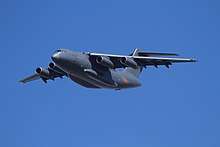Xi'an Y-20
The Xi'an Y-20 (Chinese: 运-20; pinyin: Yùn-20; lit.: 'transport-20') is a large military transport aircraft. The project is being developed by Xi'an Aircraft Industrial Corporation and was officially launched in 2006.[6] The official codename of the aircraft is Kunpeng (Chinese: 鲲鹏),[7] after the mythical bird that can fly for thousands of miles described in the ancient Chinese Taoist classic Zhuangzi.[8] However, within the Chinese aviation industry itself, the aircraft is more commonly known by its nickname Chubby Girl (Chinese: 胖妞), because its fuselage is much wider compared to other Chinese aircraft previously developed in China.[9]
| Y-20 | |
|---|---|
 | |
| Y-20 flight on Airshow China 2016 | |
| Role | Strategic airlifter |
| National origin | China |
| Manufacturer | Xi'an Aircraft Industrial Corporation |
| Designer | Tang Changhong[1] |
| First flight | 26 January 2013 |
| Introduction | 6 July 2016[2][3] |
| Status | In service, in production[2][3] |
| Primary user | People's Liberation Army Air Force |
| Produced | 2013–present |
| Number built | 20+ (December 2019)[4] |
| Unit cost |
US$160 million (flyaway cost)[5] |
Development

The aircraft was primarily designed and developed in China under Xi'an Aircraft Industrial Corporation.[10] Certain parts of the wing such as the triple-slotted trailing-edge flaps were developed by the Ukrainian Antonov Design Bureau.[11]
Design

The Y-20 uses components made of composite materials.[12] The composites are produced in China, whereas in the past they had to be imported.[13] The Y-20's cabin incorporates flame-retardant composites developed by the 703 Institute of the China Aerospace Science and Technology Corporation (CASC). The 703 Institute was created in March 2009 with development taking three years. The performance of the composites is reportedly comparable to those that fulfill FAR Part 25.835. The 703 Institute achieved another milestone by establishing a comprehensive Chinese evaluation and certification system for aircraft composite materials based on international standards.[14]
The Y-20 is the first cargo aircraft to use 3D printing technology to speed up its development and to lower its manufacturing cost.[15] Model-based definition (MBD) is also used, and it's the third aircraft to utilize MBD technology in the world, after Airbus A380 (2000) and Boeing 787 (2005).[16] A project team to implement MBD for Y-20 program was formally formed in October 2009, and after the initial success in application on the main landing gear, MBD application was expanded to the entire aircraft and became mandatory for all contractors and sub contractors of the Y-20 program.[16] The implementation of MBD was initially met with strong resistance, with only a third of suppliers agreeing to implement MBD. However, the general designer of Y-20 declared that those who refused to implement MBD will be banned from participating in the Y-20 program, thus forcing everyone to comply, resulting in increases in productivity.[16] The implementation of MBD greatly shortened the time required, for example, without MBD, installation of wings takes a month or two, but with MBD adopted, the time is drastically shortened to just a few hours, and in general, the design work reduced by 40%, preparation for production reduced by 75%, and manufacturing cycle reduced by 30%.[16]
In addition to 3D printing, the Y-20 is also the first aircraft in China adopting associative design technology (ADT) in its development.[16] Headed by the deputy general designer of structural design, Mr. Feng Jun (冯军), the initial attempt to implement ADT actually failed after two months spent on application on the nose section. It was only after the second attempt that took another three months on the application on wings did ADT became successful.[16] The adaptation of ADT greatly shortened the development time by at least eight months, and modification of wing design that previously took a week is shortened to half a day.[16]
Cargo is loaded through a large aft ramp that accommodates rolling stock. The Y-20 incorporates a shoulder wing, T-tail, rear cargo-loading assembly and heavy-duty retractable landing gear, consists of three rows, with a pair of wheels for each row, totaling six wheels for each side. The structural test was completed in 194 days as opposed to the 300 days originally planned, thanks to the successful development and application of an automated structural strength analysis system.[16] In comparison, similar work for the Xian JH-7 took a year.[16] According to the deputy general designer, the shortest take-off distance of the Y-20 is 600 to 700 meters.[9] Y-20 incorporates a total of four LCD EFIS, and the development of EFIS for Y-20 utilizes virtual reality via helmet mounted display.[9] Eight types of different relays used on Y-20 are developed by Guilin Aerospace Co., Ltd. a wholly own subsidiary of China Tri-River Aerospace Group Co., Ltd.(中国三江航天集团), which is also known as the 9th Academy of the China Aerospace Science and Industry Corporation (CASIC).[14]
It was reported that the Y-20 started ground testing in December 2012, including runway taxi tests.[17][18][19][20] The aircraft made its maiden flight lasting one hour on January 26, 2013.[21][22][23] During landing in first flight, it was reported that the Y-20 prototype bounced once before finally settling on runway due to high landing speed.[24] In December 2013, a new Y-20 prototype took to the sky.[25]
On 6 February 2016 the Y-20 was flown for the first time and pictures of the fifth prototype (serial number 788) in flight appeared on Chinese military webpages. Other known prototypes carry identification numbers 781, 783 and 785. On 27 January 2016, former Chinese test pilot, Xu Yongling, had reported in a Xinhua article that Chinese aviation industry officials had stated that the Y-20 "had completed development" at the end of 2015. In June 2016, the first two Xian Y-20 aircraft were delivered to the People's Liberation Army Air Force (PLAAF) [26]
Propulsion
The Y-20 is currently powered by four 12-ton thrust Soloviev D-30KP-2 engines,[27] and all early production units are fitted with the same engine.[28][29]
The Chinese intend to replace the D-30 with the 14-ton thrust WS-20, which is required for the Y-20 to achieve its maximum cargo capacity of 66 tons.[27] The Shenyang WS-20 is derived from the core of the Shenyang WS-10A, an indigenous Chinese turbofan engine for fighter aircraft.[30]
In 2013, the Shenyang Engine Design and Research Institute was reportedly developing the SF-A, a 28700-pound thrust engine, for the Y-20 and the Comac C919. The SF-A is derived from the core of the WS-15. Compared to the WS-20, the SF-A is a conservative design that does not seek to match the technology of more modern engines.[31]
In late 2017, it was revealed that domestic Chinese turbofan WS-18 has begun flight tests on the Y-20. Compared with Russian Soloviev D-30, the WS-18 is 300 kg lighter, weighing in at 2000 kg; with thrust increased from 12.5 per ton of the D-30 to 13.2 per ton; and fuel consumption of the WS-18 is also reduced in comparison to the D-30, and the mean time between overhaul of the WS-18 is 3000 hours.[32][33] However, because the increase in thrust is not significant in comparison to the D-30, the WS-18 is likely to be a stopgap measure before the WS-20 is ready.[32][33] In February 2019, an internet photo revealed a Y-20 prototype with serial number 783 that was equipped with a single WS-20 for testing.[34]
Cargo capacity
The estimated cargo capacity of the Y-20 in comparison to other military transport aircraft is listed below. The Y-20's capacious four-meter tall hold can lift up to 66 tons.
| Aircraft | Maximum payload (t) | Length of cargo hold | Width of cargo hold | Height of cargo hold |
|---|---|---|---|---|
| An-124 | 150 | 36 metres (118 ft) | 6.4 metres (21 ft) | 3.4 metres (11 ft) |
| C-5M | 129.274 | 37 metres (121 ft) | 5.8 metres (19 ft) | 4.1 metres (13 ft) |
| C-17 | 77.5 | 26.83 metres (88.0 ft) | 5.49 metres (18.0 ft) | 3.76 metres (12.3 ft) |
| Y-20 | 66 | 20 metres (66 ft) | 4 metres (13 ft) | 4 metres (13 ft) |
| Il-76MD | 48 | 20 metres (66 ft) | 3.4 metres (11 ft) | 3.4 metres (11 ft) |
| An-70 | 47 | 19.1 metres (63 ft) | 4 metres (13 ft) | 4.1 metres (13 ft) |
| C-2 | 36 | 16 metres (52 ft) | 4 metres (13 ft) | 4 metres (13 ft) |
| A400M | 37 | 17.71 metres (58.1 ft) | 4 metres (13 ft) | 3.85 metres (12.6 ft)[rear section:4 metres (13 ft)] |
| C-130J | 19.8 | 12.5 metres (41 ft) | 3.05 metres (10.0 ft) | 2.75 metres (9.0 ft) |
| KC-390 | 26 | 18.5 metres (61 ft) | 3.00 metres (9.84 ft) | 3.04 metres (10.0 ft) |
Operational history
In 2014 the PLA National Defence University's Center for Economic Research recommended the purchase of up to 400 Y-20s, comparing the PLAAF's needs with the existing airlifter fleets of the United States and Russia.[29] In June 2016 Jane's reported that up to 1,000 Y-20s are being requested by the Chinese military.[38][39][40][41][42][43][44]
On 6 July 2016 the first serial Y-20 (serial number 11051) was handed over to the PLAAF in a ceremony.[45] The second aircraft numbered 11052 followed soon after - it was assigned to the 12th Regiment of the 4th Transport Division at Qionglai, Chengdu.[46][26]
On 8 May 2018, it was announced by PLAAF's spokesperson Shen Jinke that Y-20 had "recently conducted its first joint airdrop training with the country's airborne troops".[47]
Starting November 2018 there were rumors about an aerial refueling variant of the Y-20.[48] It is very appreciated for PLAAF because the largest domestically-made aerial refueling aircraft is HY(Hong You, meaning "Bomber/Fuel Tanker")-6, whose capacity is limited.[49]
On 13 February 2020, the Y-20 was part of a fleet used to deliver supplies and personnel to Wuhan. The operation was part of an effort to mitigate what became the COVID-19 pandemic. A fleet of 11 aircraft was used to delivered 2,600 military medical staff to Wuhan. The PLAAF fleet of 11 aircraft consist of 6 Y-20s, 3 Il-76s and 2 Y-9s transport aircraft. [50] [51]
Operators

- 20 Y-20 airlifters seen at Yanliang Air Base. The sprawling Yanliang Air Base that also houses China's Flight Test Establishment, as well as academic institutions that deal with aircraft design.[53]
Specifications (estimated)
Data from
General characteristics
- Crew: 3
- Capacity: 66,000 kg (145,505 lb)[21]
- Length: 47 m (154 ft 2 in) [54]
- Wingspan: 45 m (147 ft 8 in) [55]
- Empty weight: 100,000 kg (220,462 lb)
- Max takeoff weight: 220,000 kg (485,017 lb)
- Powerplant: 4 × Soloviev D-30KP-2 (WS-20 planned) turbofan engines
Performance
- Maximum speed: Mach 0.75
- Range: 4,500 km (2,800 mi, 2,400 nmi) with max payload
- 7,800 km (4,847 mi) with 40,000 kg (88,185 lb)
- 10,000 km (6,214 mi)+ with paratroops.
- Service ceiling: 13,000 m (43,000 ft)
- Wing loading: 710 kg/m2 (150 lb/sq ft)
See also
| Wikimedia Commons has media related to Xian Y-20. |
Aircraft of comparable role, configuration and era
References
Notes
- "New jumbo transport jet completes more tests". East Day. Archived from the original on 5 March 2013. Retrieved 5 March 2013.
- "运-20飞机授装接装仪式举行 许其亮出席并讲话" (in Chinese). Xinhua News Agency. 6 July 2016. Archived from the original on 1 September 2016. Retrieved 6 July 2016.
- "中国空军列装运-20飞机提升战略投送能力" (in Chinese). Xinhua News Agency. 6 July 2016. Archived from the original on 6 July 2016. Retrieved 6 July 2016.
- "A Whopping 20 Y-20 Airlifters Seen at Chinese Aircraft Plant and Test Base".
- Joel, Chris (7 December 2016). "Sri Lanka to Buy 3D Printed Aircraft from China". 3dprintersonlinestore.com. Archived from the original on 7 December 2018. Retrieved 10 December 2018.
- "China's first heavy transporter Y-20 takes off". english.people.com.cn. Archived from the original on 27 January 2013. Retrieved 26 January 2013.
- "Y-20 gives air power a push". chinadaily.com.cn. Archived from the original on 28 January 2013. Retrieved 28 January 2013.
- Dave Sloggett, "THE DRAGON Gains its Strategic Wings" Air International, March 2013, pp. 94-95
- "Y-20". Sina Corp. Archived from the original on March 4, 2014. Retrieved February 15, 2014.
- "Y-20 Heavy Transport Aircraft - Military-Today.com". Archived from the original on 2015-10-03. Retrieved 2015-10-01.
- "Xian Y-20 Specification & Technical Data - Defence Aviation". www.defenceaviation.com. 25 April 2016. Archived from the original on 25 December 2017. Retrieved 8 April 2018.
- Sweetman, Bill; Perrett, Bradley (4 February 2013). "Avic Y-20 Airlifter Awaits Better Engines". Aviation Week. Archived from the original on 16 May 2018. Retrieved 5 May 2015.
- "Air Transportation: China Hits Another Major Milestone". StrategyPage. 21 February 2013. Archived from the original on 15 April 2015. Retrieved 5 May 2015.
- 胡光曲, ed. (5 February 2013). "運20機艙裝備國產新型複合材料 提高防火性能". 华夏经纬网. Archived from the original on 24 April 2015. Retrieved 5 February 2013.
- "央视首次曝光运20运输机驾驶舱内部珍贵画面". Archived from the original on 14 December 2014. Retrieved 4 February 2015.
- "Development of the Y-20". Archived from the original on August 14, 2013. Retrieved August 8, 2013.
- "Y-20 transport aircraft starts testing, first flight completed". AirForceWorld.com. Archived from the original on 2013-01-15. Retrieved 24 Dec 2012.
- "Chinese Y-20 revealed in new online pictures". Flightglobal.com. 27 December 2012. Archived from the original on 31 December 2012. Retrieved 27 December 2012.
- "IN FOCUS: China's new strategic airlifter". Flightglobal. 8 January 2013. Archived from the original on 11 January 2013. Retrieved 14 January 2013.
- David Axe (4 January 2013). "Satellites Spot China's Mysterious New Warplane". Wired. Archived from the original on 27 January 2013. Retrieved 29 January 2013.
- "我国自主发展的运—20大型运输机首次试飞取得圆满成功". news.xinhuanet.com. Archived from the original on 2013-01-28. Retrieved 26 Jan 2013.
- "视频 国产大型运输机运-20首飞成功". news.cntv.cn. Archived from the original on 29 January 2013. Retrieved 26 January 2013.
- "视频 国产大型运输机首飞成功:我国运输机发展之路". news.cntv.cn. Archived from the original on 22 February 2014. Retrieved 26 January 2013.
- "VIDEO:Y-20 prototype first flight completed". news.cntv.cn. Archived from the original on 19 February 2014. Retrieved 26 January 2013.
- "Archived copy". Archived from the original on December 17, 2013. Retrieved December 17, 2013.CS1 maint: archived copy as title (link)
- Sputnik. "'Chubby Girl': Meet China's Xian Y-20, the World's Largest Military Plane". sputniknews.com. Archived from the original on 7 November 2017. Retrieved 8 April 2018.
- Fisher, Richard D Jr (4 September 2014). "China's Y-20 'enters second phase of testing'". IHS Jane's 360. Archived from the original on 18 May 2015. Retrieved 5 May 2015.
- http://www.airforce-technology.com/projects/xian-y-20-heavy-military-transport-aircraft/%5B%5D
- Fisher, Richard D Jr; Hardy, James (28 July 2014). "China's NDU recommends 400-strong Y-20 fleet". IHS Jane's 360. Archived from the original on 18 May 2015. Retrieved 5 May 2015.
- Fisher, Richard D Jr (22 December 2013). "China marks aviation milestones with J-10B production, second Y-20 prototype flight". IHS Jane's 360. Archived from the original on 3 February 2014. Retrieved 5 May 2015.
- Perret, Bradley (7 November 2013). "Avic Engine Pushes Alternative To ACAE CJ-1000 Turbofan For the C919". Aviation Week. Archived from the original on 10 April 2016. Retrieved 5 May 2015.
- "WS-18 begun flight test on Y-20". Archived from the original on February 23, 2018. Retrieved October 24, 2017.
- "Three engines for Yun-20". Retrieved December 21, 2017.
- "WS-20 begun test on Yun-20". Retrieved February 25, 2019.
- Comparison of military transport aircraft
- Caro capacity of military transport aircraft
- Lockheed C-5 data Archived May 16, 2017, at the Wayback Machine
- chainsoff (8 June 2016). "China military fleet to get 1,000 large strategic aircraft". Archived from the original on 9 June 2016. Retrieved 8 June 2016.
- "Y-20 production debate A". Archived from the original on July 4, 2015. Retrieved November 18, 2014.
- "Y-20 production debate B". Archived from the original on December 3, 2014. Retrieved December 3, 2014.
- "Y-20 production debate C". Archived from the original on 2017-08-01. Retrieved June 20, 2016.
- "Y-20 production debate D". Archived from the original on 2017-08-01. Retrieved July 13, 2016.
- "Y-20 production debate E". Archived from the original on August 2, 2017. Retrieved November 19, 2014.
- "Y-20 production debate F". Archived from the original on August 2, 2017. Retrieved April 8, 2016.
- "运-20飞机授装接装仪式举行 许其亮出席并讲话" (in Chinese). Xinhua. 6 July 2016. Archived from the original on 1 September 2016. Retrieved 6 July 2016.
- "@Rupprecht_A on Twitter". Archived from the original on 2018-10-27. Retrieved 2016-06-17.
- "China's homegrown transport plane Y-20 conducts 1st airdrop drills". Global Times. 8 May 2018. Archived from the original on 15 May 2018. Retrieved 15 May 2018.
- "China develops Y-20 variants to perform aerial refueling missions: Military insider - China Military".
- "China Develops Y-20 Variants to Perform Aerial Refueling Missions: Military Insider".
- "2,600 PLA medical staff arrive in Wuhan".
- "1,400 military medics arrive in Wuhan to fight epidemic".
- https://nationalinterest.org/blog/buzz/who-cares-about-chinas-stealth-fighters-or-aircraft-carriers-y-20-here-88936
- "A Whopping 20 Y-20 Airlifters Seen at Chinese Aircraft Plant and Test Base".
- "Archived copy". Archived from the original on June 3, 2013. Retrieved January 29, 2013.CS1 maint: archived copy as title (link)
- "Xian Y-20 Specification & Technical Data – Defence Aviation". 25 April 2016. Archived from the original on 4 August 2016. Retrieved 8 July 2016.